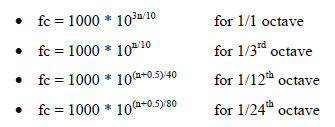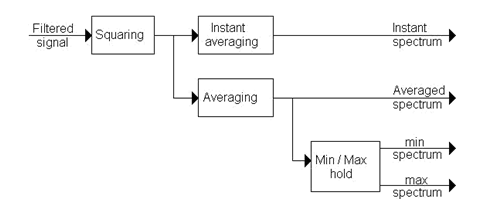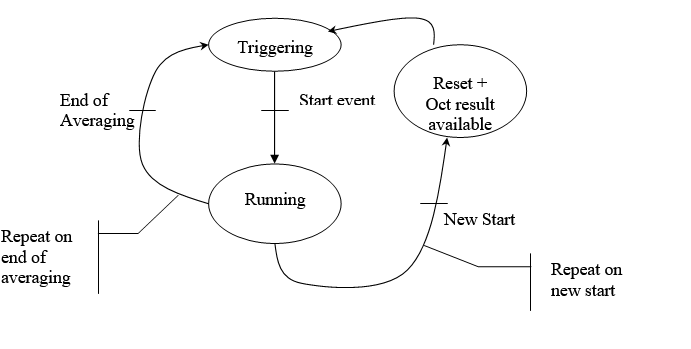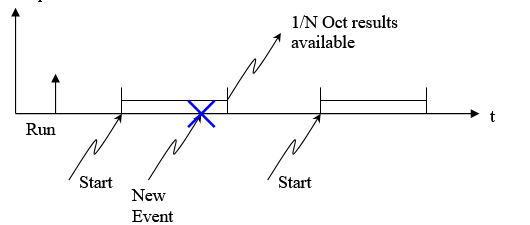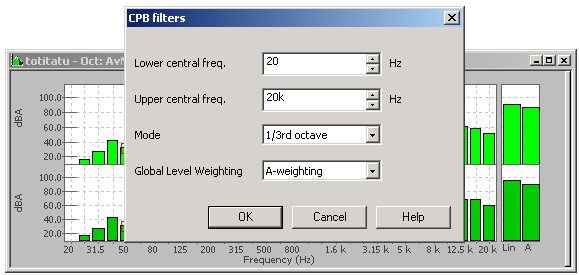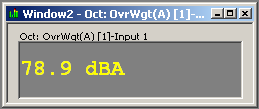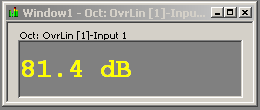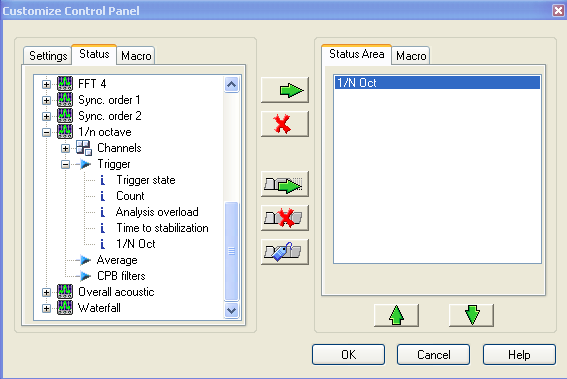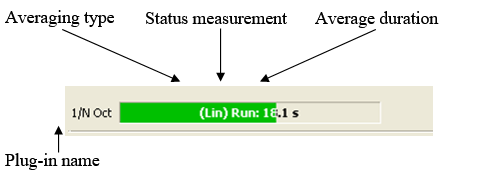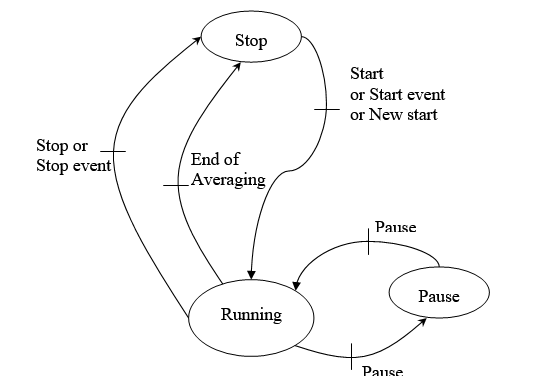Difference between revisions of "NVGate Octave Analyzer"
| Line 54: | Line 54: | ||
* covers range from 125 mHz to 16 kHz. | * covers range from 125 mHz to 16 kHz. | ||
''' 1/3<sup>rd</sup> octave filter bank:''' | |||
* can have up to 31 filters (with 1 to 1000 frequency ratio), | * can have up to 31 filters (with 1 to 1000 frequency ratio), | ||
* covers range from 100 mHz to 20 kHz. | * covers range from 100 mHz to 20 kHz. | ||
'''For 1/12<sup>th</sup> octave:''' | |||
* the filter bank gets 4 filters for each useful bandwidth of 1/3<sup>rd</sup> filters, i.e. 124 filters, | * the filter bank gets 4 filters for each useful bandwidth of 1/3<sup>rd</sup> filters, i.e. 124 filters, | ||
| Line 66: | Line 64: | ||
* covers range from 92 mHz to 21.8 kHz. | * covers range from 92 mHz to 21.8 kHz. | ||
''' For 1/24<sup>th</sup> octave:''' | '''For 1/24<sup>th</sup> octave:''' | ||
* the filter bank gets 8 filters for each useful bandwidth of 1/3<sup>rd</sup> filter, i.e. 248 filters, | * the filter bank gets 8 filters for each useful bandwidth of 1/3<sup>rd</sup> filter, i.e. 248 filters, | ||
Revision as of 10:31, 30 April 2020
NVGate Octave plug in analyzer is especially designed for vibration and acoustic signal analysis needing 1/nth octave analysis and provides 1/1, 1/3rd, 1/12th and 1/24th digital filters that conform to the the latest acoustic standards.
It provides real time analysis and post analysis results
Moreover, the user can select input time domain filters with A, B or C law and time domain digital integrators and can apply on spectral results weights with A, B or C law.
A lot of averaging modes are available and to comply with acoustic standards, detectors also provide Fast, Slow, Impulse and LEQ averaging.
Octave Tracking is available with time, RPM, or any ΔV triggering.
Display settings allow displaying Waterfall windows with cuts for octave tracking display.
Structure
Structure and Operation
The figure below shows the block diagram of the analyzer (for one channel) with octave set from 20 kHZ to 2,5kHz.
After amplification and antialias filtering, analog input signals are sampled at 51.2 kHz and converted by an analog to digital converter.
The sample frequency depends on the value of the High Filter Setting
Next, the input signals can be time weighted filters.
- A, B and C weight filters : These filters available in acoustic frequency range (i.e. from 20 Hz to 20 kHz) satisfy requirements from last standards IEC 651 type 0 and IEC 804 type 0.
- Any other NVGate filter need to be apply on Input Front end (real time) or Input Player (post analyisis).
After time domain filtering, the signals go to the digital 1/nth octave filter bank.
This filter bank is based on the 6th order digital band pass. A downsampling for low central frequency filters reduces computation load. The downsampling filters have a rejection greater than 90 dB at half of each new sampling rate and a ripple less than 0.007 dB in the useful bandwidth.
The filter range uses base 10 so that we get exact frequencies at 0.1 Hz, 1.0 Hz, 10 Hz, 100 Hz, 1 kHz and 10 kHz.
The following calculations are used to compute the central frequencies:
Number of filter and frequency range for each filter bank:
1/1 octave filter bank:
- can have up to 11 filters (with 1 to 1000 frequency ratio),
- covers range from 125 mHz to 16 kHz.
1/3rd octave filter bank:
- can have up to 31 filters (with 1 to 1000 frequency ratio),
- covers range from 100 mHz to 20 kHz.
For 1/12th octave:
- the filter bank gets 4 filters for each useful bandwidth of 1/3rd filters, i.e. 124 filters,
- covers range from 92 mHz to 21.8 kHz.
For 1/24th octave:
- the filter bank gets 8 filters for each useful bandwidth of 1/3rd filter, i.e. 248 filters,
- covers range from 90 mHz to 22.1 kHz.
Filters for 1/1 and 1/3rd octave analysis conform to the IEC 225 standard.
The OR7933 analyzer satisfies requirements from standard ANSI S1.11 - 1986 Order 3 Type 1D optional and extended range, based on maximum flat Butterworth filters. Filters bandwidth is adjusted, as recommended in ANSI 1.11, for minimum white noise bandwidth error.
For more information on filter bank setup, see 8.2.14.3 Settings | Analysis - High Filter and 8.2.14.4 Settings | Analysis - Low Filter chapters.
The next step is the detector process for each 1/nth filter:
Figure 8-2 Detector
The filtered signal is input to a squaring module in order to get true RMS detector.
This module computes 1/N * Σx²n.
The instant averaging is always running and is based on the exponential averaging with a time constant equal to 1/fc where fc is the center frequency of corresponding filter. So each detector has its own time constant and the output fluctuation in the worst case is limited to +/- 0.4 dB with a sine input signal.
The averaging process provides a lot of modes (linear, exponential and dedicated to acoustical measurements) which are described in the 8.2.14.5 Settings | Analysis - Average Mode chapter.
A hold box allows to get Maximum and Minimum spectra during one measure.
A stabilization delay is implemented in order to ignore and suppress the transient response of passband filters. It is automatically taken into account after any change of input setup. It is equal to 5 periods of the lower frequency filter for 1/3rd octave and octave filters. This delay is four times greater for 1/12th octave filters (i.e. 20 periods of the lower frequency filter) and eight times greater for 1/24th octave filters (i.e. 40 periods of the lower frequency filter).
For example, if lower frequency filter is centered at 1 Hz, then the stabilization delay is equal to 5 seconds for octave and 1/3rd octave, 20 seconds for 1/12th octave and 40 seconds for 1/24th octave. During this delay the detectors are inactive.
Finally, the analyzer stores spectrum results in order to obtain waterfall spectrum. However, the 1/nth Waterfall is somewhat different from other modes (as FFT or Tracking) in terms of implementation:
The filter bank continuously runs and instant averaging is always available (excluding time period for filter stabilization).
In linear modes, trigger events are used to start and/or stop energy computation in detectors and store associated results in the spectrum waterfall memory.
In exponential modes, detectors are always running and trigger events are only used to store associated results in the spectrum waterfall memory.
The other modules used are:
- An arming module that is used after a START command to arm trigger for the first event detection.
- A trigger module based on free start, manual, input level, delta time, tachometer with ∆ RPM capabilities and input with ∆ V variation.
For more information about arming and triggering, see corresponding chapters in Real Time FFT mode:
4.2.8 RPM Tach Setup
4.2.11 Arming Setup
4.2.12 Triggering Setup
4.2.13 Input Level Setup
4.2.14 Delta Level Setup
An internal generator is also available (see 4.2.19 Generator Setup in the real time FFT mode).
The PC ensures the real-time display functions of the traces, the management of the graphic zooms, the decoding and execution of the commands linked to the menus.
The OR7933 analyzer can manage up to 16 channels that can be selected among up to 16 inputs. A special dialog box (see 8.2.7 Input Preprocess Setup chapter in the real time mode chapter) is used to link the input channels to a preprocess on the analyzer hardware.
| F 197 804 1 | 8-11 |
Nth OCTAVE ANALYZER
REAL TIME 1/Nth OCTAVE ANALYZER
| 8-50 | F 197 804 1
NVGate 1/n octave plug inThis plug-in computes 1/1, 1/3, 1/12 and 1/24 octave analysis based on order 3 digital filters and RMS detectors. The filter bank complies with: IEC 1260 class 1 andANSI S1.11-1986 Mid band frequencies are based on powers of ten. Available results: FilterNumber = ((1/Mode) * (ln (High/Low) / ln 2)) + 1 Where: "Mode" is the value of the 1/n octave/CPB filters/Mode setting: 1 for octave, 1/3 for 1/3 octave… "High" and "Low" are respectively the values of the 1/n octave/CPB filters/Upper central freq and 1/n octave/CPB filters/Lower central freq settings For example if mode = 1/3 octave, High =7.94 kHz and Low = 7.94 Hz then FilterNumber = 3 * (ln 1000 / ln 2) +1 = 30.897 => 31 filters
Computation SPUs:
Sampling Frequency: set in Front-End/Inputs settings/Input sampling 1/N Oct Bandwidth: set in OCT/FFT analysis/range ChannelContains the settings related to the source input.
TriggerContains the settings related to triggering events and how to start and stop signal computation.
Hidden/fixed: the average type sets the authorized repeat modes.
The following scheme is a description of the two different repeat modes: - Mode Repeat on ’end of averaging’:
The ’Run’ corresponds to the start of the analyzer. The start is the beginning of average duration. At the end of the first average, the second average will start and so on till the end of the integration time (even if the last short time integration duration is not over). Each averaging has the same size, except the last that can be smaller. - Mode Repeat on ’New start’:
The ’Run’ trigger the analyzer, but the average begins at the start event (set in the event definition). This averaging stops at the end of average duration or at the stop event. Then the next averaging is waiting for the new start event to occur. In case a new event occurs during a previous averaging, this start event won’t be effective because the previous average duration is not over, you can only set other event after the end of the previous one. AverageContains the settings related to the type of averaging of the signals to be computed.
Hidden/fixed: the last five types are enabled only if the Upper central frequency is upper than 6.3 kHz.
Hidden/fixed:
CPB filtersDefines the frequency range and the resolution.
The user enters a value, which is adjusted to the closest central frequency. The bandwidth between the Lower and Upper central frequencies must be lower than or equal to eleven filters (considering octave bands) and 31 filters (considering 1/3 octave bands). So, if this bandwidth increases, then the Upper central frequency is automatically reduced.
The user enters a value, which is adjusted to the closest central frequency. The bandwidth between Lower and Upper central frequency must be lower than or equal to eleven filters (considering octave bands) and 31 filters (considering 1/3 octave bands). So, if this bandwidth increases, then the Lower central frequency is automatically increased.
Weighted overall levels of the1/n Octave Plug-in are now computed on the time domain (weighting filter and detector). Processing weighting in the time domain provides accurate measurement for non-stationary signals (impulsive). The type of time domain weighting (A or C) is selected in the ASB setting 1/n Oct / CPB filters / Global level weighting. These overall values can be displayed in view meter. /n Octave statusAll statuses are available to add to the control panel /N octThe current plug-in status is synthesized in a special progress-bar. This progress bar is automatically displayed in the ’control panel’ when the plug-in is active (i.e. as soon as at least 1 input is connected to the Sync Order plug-in). This status is called ’1/N Oct’ and it is available in the status ASB tree (see customize control panel). This status displays the type of averaging between brackets (i.e. Lin, Rep, Leq, CBT, Fast, Slow, Ipls or Exp), the plug-in state (Run, Paused, Stop) and the real-time status. The way the status bar is displayed depend on the mode selected:
The color of the background bar and of the text depends on real-time status:
Trigger stateThe following scheme describes the different states of the measurement: CountThis status displays:
Note that in linear mode, if repeat were on end of averaging, the count would restart at the end of averaging until stop event. If repeat were on new start, the count is set to zero at the end of averaging waiting for a new trigger. In Short Leq mode, the count is stopped at the end of time duration (the repeat mode is made on short duration). Analysis overloadThis status displays if during the acquisition, there were an amplitude overload (or not) of the analyzed inputs. Time to stabilizationUntil this time to stabilization is over, results are not available. All filters have a stabilization time and at any change of settings, filters need this time before the results are available. The lower the frequency is the longer this stabilization is. The filters stabilization time is given by: Time (s) = x * 5 / lower central frequency Where x depends on the mode:
If there were no change between two run, no stabilization would be necessary. But if a new plug-in is connected, the system is reinitialized and then there is a time to stabilization. |

